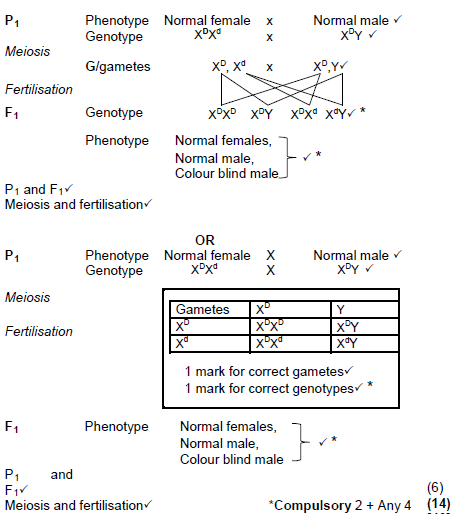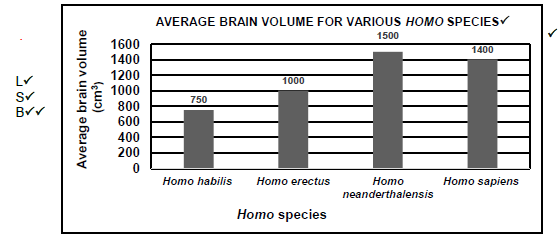LIFE SCIENCES GRADE 12 PAPER 2 MEMORANDUM - NSC PAST PAPERS AND MEMOS NOVEMBER 2017
Share via Whatsapp Join our WhatsApp Group Join our Telegram GroupLIFE SCIENCES PAPER 2
GRADE 12
NOVEMBER 2017
MEMORANDUM
NATIONAL SENIOR CERTIFICATE
PRINCIPLES RELATED TO MARKING LIFE SCIENCES
- If more information than marks allocated is given
Stop marking when maximum marks is reached and put a wavy line and 'max' in the right-hand margin. - If, for example, three reasons are required and five are given
Mark the first three irrespective of whether all or some are correct/incorrect. - If whole process is given when only a part of it is required
Read all and credit the relevant part. - If comparisons are asked for, but descriptions are given
Accept if the differences/similarities are clear. - If tabulation is required, but paragraphs are given
Candidates will lose marks for not tabulating. - If diagrams are given with annotations when descriptions are required
Candidates will lose marks. - If flow charts are given instead of descriptions
Candidates will lose marks. - If sequence is muddled and links do not make sense
Where sequence and links are correct, credit. Where sequence and links are incorrect, do not credit. If sequence and links become correct again, resume credit. - Non-recognised abbreviations
Accept if first defined in answer. If not defined, do not credit the unrecognised abbreviation, but credit the rest of the answer if correct. - Wrong numbering
If answer fits into the correct sequence of questions, but the wrong number is given, it is acceptable. - If language used changes the intended meaning
Do not accept. - Spelling errors
If recognisable, accept the answer, provided it does not mean something else in Life Sciences or if it is out of context. - If common names are given in terminology
Accept, provided it was accepted at the national memo discussion meeting. - If only the letter is asked for, but only the name is given (and vice versa)
Do not credit. - If units are not given in measurements
Candidates will lose marks. Memorandum will allocate marks for units separately. - Be sensitive to the sense of an answer, which may be stated in a different way.
- Caption
All illustrations (diagrams, graphs, tables, etc.) must have a caption. - Code-switching of official languages (terms and concepts)
A single word or two that appear(s) in any official language other than the learner's assessment language used to the greatest extent in his/her answers should be credited, if it is correct. A marker that is proficient in the relevant official language should be consulted. This is applicable to all official languages. - Changes to the memorandum
No changes must be made to the memoranda. The provincial internal moderator must be consulted, who in turn will consult with the national internal moderator (and the Umalusi moderators where necessary). - Official memoranda
Only memoranda bearing the signatures of the national internal moderator and the Umalusi moderators and distributed by the National Department of Basic Education via the provinces must be used.
SECTION A
QUESTION 1
1.1
1.1.1 B✓✓
1.1.2 D✓✓
1.1.3 C✓✓
1.1.4 B✓✓
1.1.5 C✓✓
1.1.6 B✓✓
1.1.7 A✓✓
1.1.8 C✓✓
1.1.9 C✓✓
1.1.10 D✓✓ (10 x 2)
(20)
1.2
1.2.1 Uracil✓
1.2.2 Biotechnology✓/genetic engineering/genetic manipulation/genetic modification
1.2.3 Continuous✓variation
1.2.4 Bipedalism✓/bipedal
1.2.5 Deoxyribose✓
1.2.6 Haemophilia✓
1.2.7 Palaeontology✓
1.2.8 Biogeography✓
1.2.9 Hominidae✓ (9 x 1)
(9)
1.3
1.3.1 A only✓✓
1.3.2 A only✓✓
1.3.3 B only✓✓ (3 x 2)
(6)
1.4
1.4.1
- Genes✓/alleles(1)
- Monohybrid✓(1)
1.4.2 Ovary✓/gynaecium/pistil/ovule(1)
1.4.3
- 2✓/Two(1)
- 4✓/Four(1)
1.4.4
- Violet✓(1)
- Short✓(1)
1.4.5 2✓/Two (1)
(8)
1.5.1
1.5.1 Translation✓(1)
1.5.2
- Ribosome✓(1)
- mRNA✓/messenger RNA(1)
- Peptide✓(1)
1.5.3
- C✓(1)
- B✓(1)
- D✓(1)
(7)
TOTAL SECTION A :[50]
SECTION B
QUESTION 2
2.1
2.1.1 2✓ (1)
2.1.2 CUC✓ (1)
2.1.3
- TGG✓(1)
- Aspartate✓(1)
2.1.4
-
- C was replaced by U✓ on the 4th codon✓/AGC
OR - AGC✓/the 4th codon changed to AGU✓(2)
- C was replaced by U✓ on the 4th codon✓/AGC
-
- It codes for the same amino acid✓/serine
- Therefore there will be no effect✓/same protein formed(2)
2.1.5
- The process is transcription✓* Compulsory mark
- The double helix DNA molecule unwinds✓
- When the hydrogen bonds break✓
- the DNA molecule unzips✓/2 DNA strands separate
- One strand is used as the template ✓to form mRNA
- using free RNA nucleotides✓from the nucleoplasm
- The mRNA is complementary to DNA✓/A-U, C-G
- This process is controlled by enzymes✓ 1* + Any 5(6)
(14)
2.2
2.2.1
- A population is a group of organisms of the same species✓/that can interbreed to produce fertile offspring and
- occupy a given area at a certain time✓(2)
2.2.2
- Crossing over✓
- Random arrangement✓ of chromosomes
- Random fertilisation✓
- Random mating✓ Any 3
(Mark first THREE only)(3)
2.2.3
- The squirrels with favourable characteristics✓ caused by the mutation
- survive✓/natural selection occurs
- since they are better suited✓ to the environmental conditions
- These characteristics are passed on to future generations✓
Any 3(3)
2.2.4
- Since there are now two✓ species/a new species of squirrels
- the biodiversity has increased✓(2)
2.2.5
- Allow them to interbreed✓/reproduce/mate
- They will not produce fertile offspring✓/check if they produce fertile offspring
OR - Conduct DNA tests✓ of both species
- and compare them✓(2)
(12)
2.3
2.3.1
- Colour blind male✓/male with Daltonism(1)
- XDXd✓(1)
2.3.2
- Linda inherited one recessive allele/Xd from her father✓
- and one recessive allele/Xd from her mother✓(2)
2.3.3
- Males only have one X-chromosome✓
- If this chromosome carries the recessive allele✓/Xd
- the male will be colour blind✓
- Females have 2 X-chromosomes✓
- They need to have two recessive alleles✓/Xd Xd to be affected
- A dominant allele on the other X-chromosome will mask the effect✓
Any 4(4)
2.3.4
[40]
QUESTION 3
3.1
3.1.1
- Genetic✓/mitochondrial DNA /Y chromosome
- Cultural✓(2)
(Mark first TWO only)
3.1.2 Ardipithecus ramidus✓
(Mark first ONE only)(1)
3.1.3
- They would measure the volume✓
- of the cranium✓of the fossil(2)
3.1.4 (1400 - 500)✓
= 900✓cm3(2)
3.1.5
- There is an overlap in their period of existence✓/they both existed between 2 and 1,6 mya(1)
-
- It has the smallest brain volume✓
- It appeared first✓/is the oldest Any 1(1)
3.1.6
Guideline for assessing the graph:
| Bar graph drawn | |
| Title of graph includes both variables | |
| Correct label for X-axis Correct label and unit for Y-axis (cm3) (L) | |
| Equal width and interval of bars Correct scale for Y axis (S) | |
| Required bars drawn (B) | 1 Only REQUIRED bars drawn |
| Drawing of bars (B) | 1 All 4 REQUIRED bars drawn correctly |
3.2
3.2.1
- Taste✓/sweetness
- Size✓/largest fruits(2)
3.2.2
- Humans✓/villagers
- select the fruits with desirable characteristics✓/sweetest and largest fruits
- and scatter✓/grow them/use them to form the next generation of offspring(3)
3.2.3
- Climate✓
- Temperature✓
- Water✓
- Soil✓
- Light✓
- Humidity✓
- Gases✓ Any 1
(Mark first ONE only)(1)
3.2.4
- If trees are produced through marcotting there would be no variation within the plantation✓/trees would be genetically identical
- Any change in the environment/diseases/insects affecting one tree will probably destroy the whole plantation✓ /no other characteristics will be introduced
(Mark first ONE only)(2)
(12)
3.2.5
- No✓/ the fruits cannot be labelled as genetically modified (GM)
- because no gene transfer✓/introduction in the marcotting process took place(2)
3.2.6
- Production of medication/resources cheaply✓
- Control pests with specific genes inserted into a crop✓
- Using specific genes to increase crop yields✓/food security
- Introduction of genes to improve human health✓
- Selecting genes to increase shelf-life of plant products✓
- Improving the quality of the crop✓
- Allows a faster production time✓
- Developing resistance to drought✓
- Developing resistance to pests✓
- Developing resistance to herbicides✓
- Developing resistance to diseases✓ Any 2
(Mark first TWO only) (2)
(12)
3.3
3.3.1
- Habitat✓/colour of sand
- Fur colour✓
(Mark first TWO only)(2)
3.3.2 100(1)
3.3.3
- They used a large sample size✓/200 models per habitat/ 200 models per fur colour/ 400 models in total
- Allowed enough time for predators to attack the models✓
- Placed mice randomly in each habitat✓ Any 2
(Mark first TWO only)(2)
3.3.4 The darker coloured models were attacked less✓✓ than the lighter coloured models
OR
The lighter coloured models were attacked more✓✓ than the darker coloured models(2)
3.3.5
- More mice/78 models with dark fur colour were attacked✓ in the beach habitat
- as they were more visible✓/less camouflaged against the light coloured sand
- Fewer mice with light fur colour/26 models were attacked✓ in the beach habitat
- as they are less visible✓/well camouflaged against the light coloured sand(4)
3.3.6
- The clay models are not able to escape✓ from predators
- and therefore they would be attacked more frequently✓
OR - The owls will not recognise the models as prey✓and
- therefore will attack less frequently✓
OR - if the models showed signs of an attack✓
- it doesn’t give an indication of their survival ✓ (2)
(13)
[40]
TOTAL SECTION B: 80
SECTION C
QUESTION 4
STRUCTURE AND ARRANGEMENT OF CHROMOSOMES
- Each chromosome comprises two chromatids✓
- held together by a centromere✓
- There are 23 pairs✓/46 chromosomes in
- human somatic cells✓/body cells
- which are arranged into homologous pairs✓
- that are similar in length✓
- carry genes for the same characteristics✓
- have alleles of a particular gene at the same loci✓and
- have the same centromere position✓
- Each somatic cell has 22 pairs/44 autosomes✓and
- a pair/2 gonosomes✓/sex chromosomes/X and Y chromosomes
- Autosomes are arranged in pairs from largest to smallest✓ in a karyotype
- Males have XY chromosomes✓
- Females have XX chromosomes✓
- The X chromosome is larger than the Y chromosome✓ Max 8(8)
BEHAVIOUR OF CHROMOSOMES IN MEIOSIS I
- During prophase✓ I
- chromosomes pair✓up/homologous pairs/bivalents form
- Crossing over✓/exchange of genetic material occurs
- between chromatids✓/adjacent chromosome pairs
- During metaphase✓ I of meiosis
- homologous chromosomes✓/chromosome pairs are arranged
- at the equator✓ of the cell
- in a random✓ way
- with the chromosome attached to the spindle fibre✓
- During anaphase✓I
- chromosome pairs separate✓/chromosomes move to opposite poles
- During telophase✓ I
- the chromosomes reach the poles of the cell✓Max 9(9)
Content(17)
Synthesis(3)
(20)
ASSESSING THE PRESENTATION OF THE ESSAY
| Criterion | Relevance (R) | Logical sequence (L) | Comprehensive (C) |
| Generally | All information provided is relevant to the question. | Ideas are arranged in a logical sequence. | All aspects of the essay have been sufficiently addressed. |
| In this essay in Q4 | Only information relevant to structure and arrangement of human chromosomes and their behaviour in the different phases of meiosis I is given. No irrelevant information included. | The description of structure and arrangement of human chromosomes and their behaviour in the different phases of meiosis I is given in a logical and sequential manner. | At least the following marks should be obtained - 5/8 for the structure and arrangement of human chromosome - 6/9 for behaviour during meiosis I |
| Mark | 1 | 1 | 1 |
TOTAL SECTION C:20
GRAND TOTAL:150

